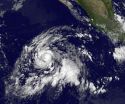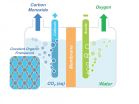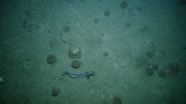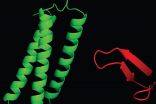(Press-News.org) TALLAHASSEE, Fla. -- Florida State University researchers have taken a big step forward in the fight against cancer with a discovery that could open up the door for new research and treatment options.
Fanxiu Zhu, the FSU Margaret and Mary Pfeiffer Endowed Professor for Cancer Research, and his team uncovered a viral protein in the cell that inhibits the major DNA sensor and thus the body's response to viral infection, suggesting that this cellular pathway could be manipulated to help a person fight infection, cancer or autoimmune diseases.
They named the protein KicGas.
"We can manipulate the protein and/or the sensor to boost or tune down the immune response in order to fight infectious and autoimmune diseases, as well as cancers," Zhu said.
The study was published today in the journal Cell Host and Microbe.
Zhu leads a research team investigating how DNA viruses can cause cancer, a major focus of researchers worldwide. About 15 percent of human cancer cases are caused by viruses, so scientists have been seeking answers about how the body responds to viral infection and how some viruses maintain life-long infections.
In the past few years, researchers finally identified the major DNA sensor in cells, known as cGas. That spurred researchers to further examine this sensor in the context of human disease because ideally that sensor should have been alerting the body to fight disease brought by a DNA virus.
Essentially, a DNA virus is an intracellular parasite that contains genetic material. Several notable diseases including smallpox, herpes, and chickenpox are caused by DNA viruses. One of the reasons these diseases are so difficult to cure is because they take over the cellular machinery of their human host, often making it impossible to kill the virus without also harming the person.
Although people are equipped with sophisticated immune systems to cope with viral infection, many viruses have co-evolved mechanisms to evade or suppress the body's immune responses.
So the discovery of this protein is critical to further exploration of how these DNA viruses work and how they can be thwarted.
To uncover this protein, Zhu's team studies Kaposi's sarcoma-associated herpesvirus (KSHV), a human herpesvirus that causes some forms of lymphoma and Kaposi's sarcoma, a cancer commonly occurring in AIDS patients and other immunocompromised individuals.
In this study, researchers screened every protein in a KSHV cell -- 90 in total -- and ultimately found that one of them directly inhibited the DNA sensor called cGAS. They infected human cell lines with the Kaposi's sarcoma virus to mimic natural infection, and found when they eliminated the inhibitor protein -- KicGas -- the cells produced a much stronger immune response.
To do this work, Zhu collaborated with several scientists both in the U.S. and Germany, including FSU Professor of Chemistry and Biochemistry Hong Li.
Li, whose focuses are molecular biology and molecular biophysics, specifically examined how the protein inhibited the cGAS activity in test tubes. For the next phase of research, she is building a three-dimensional model of the interactions to help them better understand how the inhibitor functions.
"These are hard problems to solve, and there is still much to learn here," Li said.
Learning how the inhibitor functions is a big next step, though.
"Once we figure that out, we can hopefully design something to fight the disease," Zhu said.
INFORMATION:
Other institutions contributing to the paper are the Frederick National Laboratory for Cancer Research, Friedrich-Alexander-University in Germany and the Institute of Clinical and Molecular Virology at University of Erlangen-Nürnberg.
The research is funded by the National Institutes of Health. END
Brief intervals of exercise during otherwise sedentary periods may offset the lack of more sustained exercise and could protect children against diabetes, cardiovascular disease and cancer, according to a small study by researchers at the National Institutes of Health
Children who interrupted periods of sitting with three minutes of moderate-intensity walking every half hour had lower levels of blood glucose and insulin, compared to periods when they remained seated for three hours. Moreover, on the day they walked, the children did not eat any more at lunch than on ...
Washington, DC--People who developed Type 2 diabetes tended to take more antibiotics in the years leading up to the diagnosis than people who did not have the condition, according to a new study published in the Endocrine Society's Journal of Clinical Endocrinology & Metabolism.
A person develops diabetes, which is characterized by high blood sugar levels, when the individual cannot produce enough of the hormone insulin or insulin does not work properly to clear sugar from the bloodstream.
More than 29 million Americans have diabetes, according to the Society's Endocrine ...
Washington, DC--Taking 3-minute breaks to walk in the middle of a TV marathon or other sedentary activity can improve children's blood sugar compared to continuously sitting, according to a new National Institutes of Health (NIH) study published in the Endocrine Society's Journal of Clinical Endocrinology & Metabolism (JCEM).
A sedentary lifestyle can put children at risk of developing pediatric obesity and metabolic health problems such as diabetes. Nearly 17 percent of children and teens nationwide are obese, according to the Society's Endocrine Facts and Figures report. ...
Washington, DC--For years after it was administered, growth hormone continued to reduce the risk of fractures and helped maintain bone density in postmenopausal women who had osteoporosis, according to a new study published in the Endocrine Society's Journal of Clinical Endocrinology & Metabolism.
Osteoporosis is a progressive condition that causes the bones to become weak and more likely to break. More than 10 million American adults have osteoporosis, and 80 percent of the people being treated for the condition nationwide are women, according to the Society's Endocrine ...
NASA's Aqua satellite and NOAA's GOES-West satellite provided temperature and cloud data on newborn Tropical Storm Jimena in the Eastern Pacific Ocean. Data from both satellites show the storm continues to consolidate.
Tropical Depression 13E formed about 865 miles (1,390 km) south-southwest of the southern tip of Baja California, Mexico at 5 p.m. EDT (2100 UTC) on August 26. Six hours later, the depression strengthened into Tropical Storm Jimena at 11 p.m. EDT.
A false-colored infrared image from Aug. 27 at 09:47 UTC (4:57 a.m. EDT) showed high, cold, strong thunderstorms ...
A molecular system that holds great promise for the capture and storage of carbon dioxide has been modified so that it now also holds great promise as a catalyst for converting captured carbon dioxide into valuable chemical products. Researchers with the U.S. Department of Energy (DOE)'s Lawrence Berkeley National Laboratory (Berkeley Lab) have incorporated molecules of carbon dioxide reduction catalysts into the sponge-like crystals of covalent organic frameworks (COFs). This creates a molecular system that not only absorbs carbon dioxide, but also selectively reduces ...
Researchers reporting in the Cell Press journal Current Biology on August 27 have evidence in support of a clearly defined depth limit for deep-sea fishing in Europe. The findings come just as the European Union considers controversial new legislation to manage deep-sea fisheries, including a ban on trawling below 600 meters.
"The most notable thing to consider about our findings is that the trend in catch composition over the depth range of 600 to 800 meters shows that collateral ecological impacts are significantly increasing while the commercial gain per unit effort ...
Isaac Newton was a classic neurotic. He was a brooder and a worrier, prone to dwelling on the scientific problems before him as well as his childhood sins. But Newton also had creative breakthroughs--thoughts on physics so profound that they are still part of a standard science education.
In a Trends in Cognitive Sciences Opinion paper published August 27, psychologists present a new theory for why neurotic unhappiness and creativity go hand-in-hand. The authors argue that the part of the brain responsible for self-generated thought is highly active in neuroticism, which ...
Researchers at the Virginia Bioinformatics Institute at Virginia Tech have uncovered key cellular functions that help regulate inflammation -- a discovery that could have important implications for the treatment of allergies, heart disease, and certain forms of cancer.
The discovery, to be published in the Oct. 6 issue of the journal Structure, explains how two particular proteins, Tollip and Tom1, work together to contribute to the turnover of cell-surface receptor proteins that trigger inflammation.
"The inflammatory response can be a double-edged sword," said Daniel ...
Mobility between different physical environments in the cell nucleus regulates the daily oscillations in the activity of genes that are controlled by the internal biological clock, according to a study that is published in the journal Molecular Cell. Eventually, these findings may lead to novel therapeutic strategies for the treatment of diseases linked with disrupted circadian rhythm.
So called clock-controlled - or circadian - genes are part of the internal biological clock, allowing humans and other light-sensitive organisms to adjust their daily activity to the cycle ...




